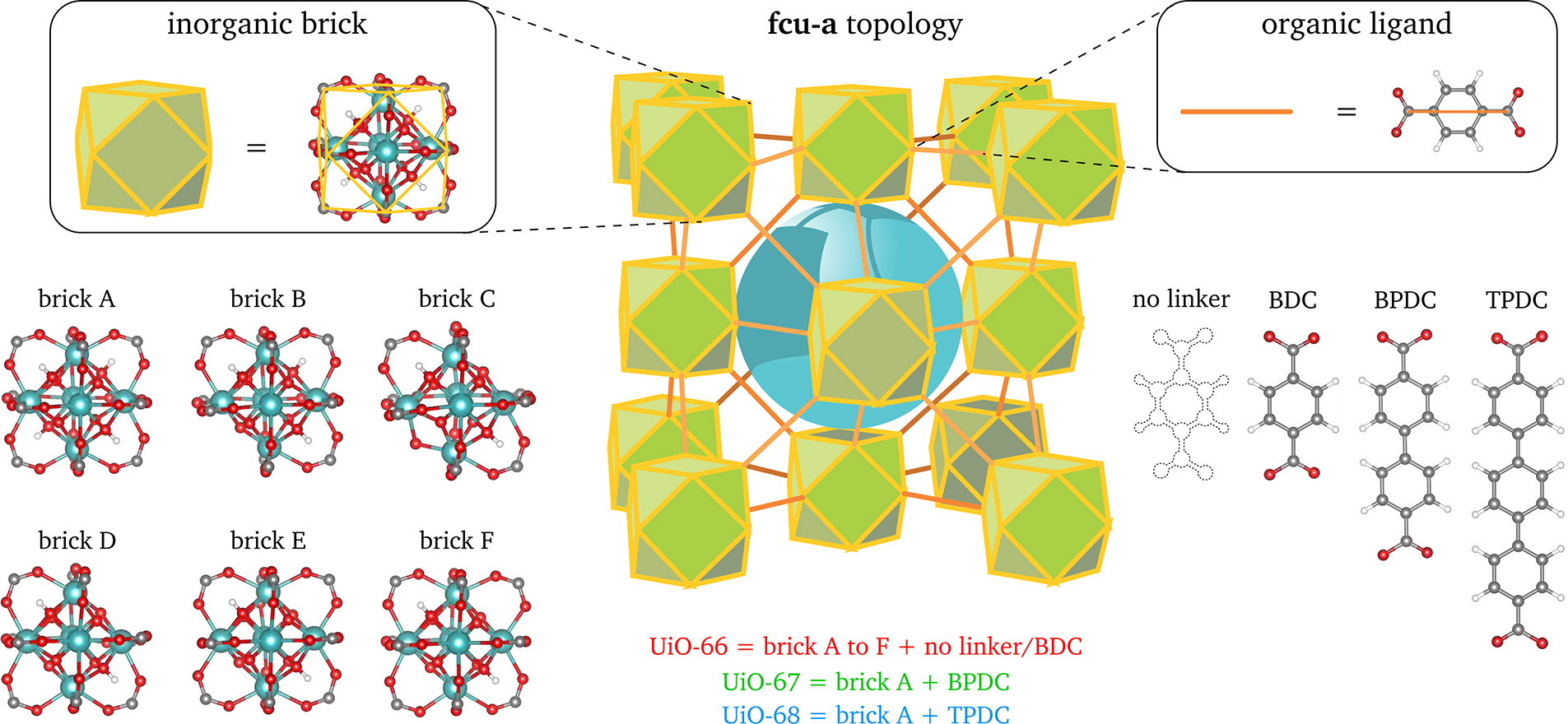Defect engineering in UiO-66 following a combined experimental/theoretical approach
Defect engineering in UiO-66 following a combined experimental/theoretical approach
Promotor(en): V. Van Speybroeck, H. Vrielinck /28301 / SpectroscopyBackground and problem
In recent years, crystalline nanoporous materials such as metal-organic frameworks (MOFs) have been widely investigated for their potential use in various applications such as gas storage, gas separation, catalysis of chemical reactions and drug delivery systems. The main features of these materials responsible for such applications are their large internal pores and long-range ordered structure, allowing them to accommodate various guest molecules inside these pores. MOFs are built from metal-oxide centers connected through organic linkers. This hybrid nature gives rise to fascinating structural properties. In MOFs defects can be introduced in a rather predictable way (defect engineering), which can improve their performance as catalyst for various chemical processes [1]. However, the use of defect engineered MOFs in present-day applications remains limited due to stability issues. A worthy candidate to overcome this problem is UiO-66, which possesses clusters of high-valent metal cations with high charge densities enhancing the stability. Moreover, its unique structure allows for a large concentration of defects without loss of structure. Generally, the insertion of defects reduces the thermal stability of the framework, although in rare cases the opposite is true [2]. The effect of different types of defects on the structural properties of UiO-66 is not easily understood and requires an in-depth structural investigation.
To rationalize defect engineering in UiO-66, a common procedure is to apply a combination of experimental and computational techniques, uniting the strengths of both [3]. For example, the resulting diffraction patterns from X-ray diffraction (XRD) experiments contains information about the geometry and structure of the material and can be compared with the equilibrium geometry predicted by quantum mechanical calculations, while lattice vibrations and the electronic band structure are directly related to various spectroscopic techniques such as infrared (IR) absorption spectroscopy and ultraviolet-visible (UV/VIS) spectroscopy. Furthermore, by means of far-IR spectroscopy, we can focus on the low-frequency vibrations, which correspond to delocalized degrees of freedom related to various forms of framework dynamics [4].

Figure 1: Visualization of the UiO-66 topology with different types of node defects. Figure taken from Ref. [1]
Goal
In this thesis subject, both experimental and computational techniques will be applied to study the structural properties of UiO-66 via vibrational spectroscopy. A thorough investigation of the specific vibrational fingerprint regions will lead to a better understanding of the impact of defects on the stability.
From the experimental point of view, UiO-66 samples with different types of defects will be characterized with X-ray diffraction (XRD) and infrared spectroscopy. The XRD pattern provides an easy quality check for the crystallinity of nanoporous materials and also allows to determine their crystal structure. To obtain a deeper insight in the structural properties of the examined materials, optical absorption spectra will be recorded in the far-IR and the mid-IR region. Both regions offer specific information on the material under study. The far-IR region, containing vibrations which extend over the framework unit cell, will be of interest for the characterization of framework dynamics. The presence of defects can profoundly alter the low-frequency vibrations and, hence, has an impact on the stability. Next, the mid-IR region contains fingerprint vibrations of molecular building blocks, which can be used to detect and characterize specific defects.
By means of molecular modeling, one can investigate the structure and vibrational modes on a molecular level. Using quantum mechanical calculations based on density functional theory (DFT), one can compute the geometric and electronic structure of these materials. As a result, we can compute several observables such as the XRD pattern as well as the IR spectrum and compare it with the experimental results. The theoretical vibrational spectra will be determined via two independent approaches [4]. The most common strategy starts from a static picture, in which the potential energy surface around equilibrium is approximated through a set of harmonic oscillators. However, to allow for a true comparison with experiments, it is essential to model this material at the real operating conditions. These conditions can be introduced via molecular dynamics (MD) simulations, which take temperature effects and anharmonicities into account by integrating the Newton equations of motions over time. This comes at the cost of an increased computational load.
This thesis comprises both experiments and computational modeling. Depending on the interest of the student, the focus can be shifted towards one or the other. The materials will be synthesized at COMOC (Center for Ordered Materials, Organometallics and Catalysis, UGent, prof. P. Van Der Voort), hence this research will be performed in close collaboration with this research group.
- Study programmeMaster of Science in Engineering Physics [EMPHYS], Master of Science in Physics and Astronomy [CMFYST]KeywordsMetal-organic frameworks, infrared spectroscopy, quantum mechanical calculations, X-Ray DiffractionReferences
[1] S. M. J. Rogge, J. Wieme, L. Vanduyfhuys, S. Vandenbrande, G. Maurin, T. Verstraelen, M. Waroquier, and V. Van Speybroeck, Thermodynamic insight in the high-pressure behavior of UiO-66: effect of linker defects and linker expansion, Chem. Mater. 28, p. 5721-5732 (2016)
[2] X. Feng, J. Hajek, H. S. Jena, C. Krishnaraj, D. A. Esteban, K. Leus, G. Wang, J. Sun, M. Rüscher, J. Timoshenko, B. R. Cuenya, S. Bals, and P. Van Der Voort, Creation of exclusive artificial cluster defects by selective metal removal in the (Zn, Zr) mixed-metal UiO-66, J. Am. Chem. Soc. 143, p. 21511-21518 (2021)
[3] L. Valenzano, B. Civalleri, S. Chavan, S. Bordiga, M. H. Nilsen, S. Jakobsen, K. P. Lillerud, and C. Lamberti, Disclosing the complex structure of UiO-66 metal organic framework: a synergic combination of experiment and theory, Chem. Mater. 23, p. 1700-1718 (2011)
[4] A. E. J. Hoffman, L. Vanduyfhuys, I. Nevjestić, J. Wieme, S. M. J. Rogge, H. Depauw, P. Van Der Voort, H. Vrielinck, V. Van Speybroeck, Elucidating the vibrational fingerprint of the flexible metal-organic framework MIL-53(Al) using a combined experimental/computational approach, J. Phys. Chem. C 122, p. 2734-2746 (2018)
